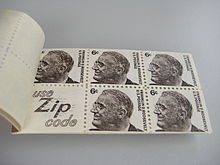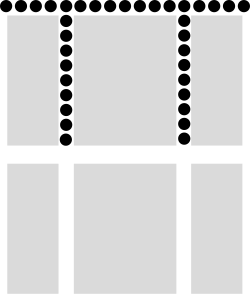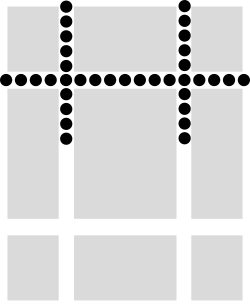Stamp separation
Under postage stamp separation is understood in the philatelic the different ways to separate a stamp of one or more other stamps that are related to the production with her. A distinction is made between imperforate, perforated and pierced stamps.
history
The world's first postage stamp, issued in Great Britain on May 1, 1840, was not yet perforated. The postman had to cut it out of the sheet with scissors . It was arduous work. Nevertheless, the first stamp issues in other countries were also issued without perforation. However, Briton Henry Archer thought about a better way to separate than with scissors. First he constructed a puncture machine. This worked through the use of small knives that sat close together and made small cuts in the stamp paper between the stamps at regular intervals. The world's first pierced postage stamps appeared at post offices on a trial basis in 1848 . However, Henry Archer was not completely satisfied with his machine. He improved them more and more and soon replaced the fine knives with perforated pins. This new system of stamp separation soon found great acceptance among post office officials. After the first perforated stamps were issued in Great Britain, numerous other postal administrations followed with this innovation.
Without perforation
All postage stamps that are neither perforated nor perforated are called imperforate in philately . Here, too, the philatelist differentiates between two different types of imperforate stamps, as there can be two different reasons for them.
Cut

All postage stamps that were deliberately issued without perforation by the respective postal administration are referred to as cut.
The world's first postage stamps could only be delivered cut, as there was no way of perforation at the time of issue. However, the issue of cut stamps in later times can be traced back to other causes: In times of crisis , the perforation of the stamps is sometimes dispensed with in order to save costs. Excessive demand for certain postage stamps can also lead to a postal administration being forced to deliver the sheets to the counters without perforation. Finally, various postal administrations issue philatelically motivated editions in small editions in addition to the perforated normal editions (e.g. Hungary).
In contrast to perforated postage stamps, where the perforation should be the same for all postage stamps, the philatelist differentiates between several quality levels for cut postage stamps. Here it depends on the accuracy of the postman, with which he separated the stamps from the sheet with his scissors. Accordingly, one classifies:
- Oversized stamps (The white border is oversized on all sides of the stamp, and you can sometimes see the border of the neighboring stamps.)
- Wide-margined stamps (The margins are usually larger than average; there is more than half of the space between the stamps in the sheet.)
- Full-margined stamps (The margin is half the size of the space between the stamps on all sides.)
- Narrow-edged stamps (The edge of the stamp is only minimal.)
- Stamps with magnifying glass edges (the edge can literally only be guessed with the help of a magnifying glass.)
- Bleed stamps (Part of the stamp was cut away when it was separated.)
Most philatelists prefer full-margined stamps for their collections. The catalog price of numerous stamp catalogs is also based on their value . Much higher amounts are often paid for the quality levels above. Postage stamps with oversized margins are particularly popular. Lower quality items are only collected from very valuable stamps. Otherwise, they often serve as gap fillers or placeholders .
With some issues, however, it is difficult to find halfway nice styles, as the space between the stamps in the sheet was only very thin. Such stamps can be found for example from Baden and the Thurn-und-Taxis-Post .
Imperforate and imperforate
The philatelist calls unperforated and unpunched stamps which were intended for perforation but which escaped this process. Imperforate stamps cannot be visually differentiated from cut ones.
This peculiarity can arise in different ways. Sometimes it happens that imperforate sheets are accidentally placed on top of the already perforated stamp pile. Another reason for the development of imperforated stamps could be the perforation or puncture machine itself. Sometimes it happens that the bottom (or more) sheet of stamps remains imperforated.
There are also so-called partial teeth . These are stamp sheets in which only some of the stamps are imperforated. One-sided or three-sided unperforated postage stamps can also be found in such sheets. There are also various causes for the development of partial teeth. Partial teeth can occur, for example, if the cutting machine is stopped too early, that is, it was not yet finished with the cutting process. If sheets are placed very imprecisely in a perforating machine, it can also happen that the top or bottom line remains imperforated.
Stamps that were accidentally unperforated are rarely found. For this reason, however, they are also very popular with appropriately specialized philatelists. Almost all unperforated stamps and partial perforations are discovered and retained before delivery.
It happens again and again that imperforated stamps are stolen from the waste and then end up on the market . However, such stamps are philatelically worthless.
Puncture

The puncture is the oldest type of perforation for postage stamps. However, like the imperforate postage stamps, it occurs not only in the early years of postage stamps, but also in times of crisis.
The puncture is done by small knives, which can have different shapes. These make small cuts in the paper between the stamps at regular intervals so that only narrow paper bridges remain. Due to the multitude of different knife shapes, punctures appear in different ways. A distinction is made between the following types:
- Arch puncture
- Line puncture
- Point puncture
- Saw tooth puncture
- Wave puncture
- Zigzag puncture
- Tongue puncture
Puncture stamps are often damaged when separated, especially if the stamp paper is difficult to tear. As a result, the puncture has not proven to be an ideal means of perforation, although it is much cheaper and easier to manufacture than perforation.
A special feature that can be found with the piercing is the colored piercing , for example on the first stamps from Thurn und Taxis. This occurs when the puncture is already marked with colored lines when the stamps are printed .
perforation
Perforation is the most modern way of perforating postage stamps. In the early years of its history it was sometimes poorly executed; today, however, it has spread throughout the world and has become a characteristic of postage stamps.
Perforation works on a similar principle to puncture, only here perforated pins punch small holes in the spaces between the stamps at regular intervals. The perforated pins are attached to the toothed strip. There are three different types.
Line perforation

Line perforation is the oldest way of perforating stamps. The bow is first toothed in one direction (e.g. horizontally). Then it is rotated 90 degrees and the other spaces between the stamps (in this case the vertical spaces) are perforated. Since this type is very imprecise, the spacing between the individual lines often varies, which results in stamps in slightly different formats. The corners of the individual stamps are naturally irregular. This is the characteristic distinguishing feature of the line perforation.
Serration
Another way to tooth stamps is to use a comb. A distinction is made between two types of arrangement of the perforated pins.
With simple comb serration , all marks in a row are serrated on three sides (top or bottom, left and right) in one operation. The corners of the individual stamps are therefore regular. A special form of simple comb teeth is double comb teeth . With her two lines are perforated at once according to this scheme.
The cross-comb serration works according to a similar system as the simple comb serration. Here, however, the stamps are perforated in an H-shape line by line, that is, the perforated pins are present in the entire horizontal length of the sheet and up to the two half stamp heights of the adjacent stamps. With this type of perforation, the corners of the stamp also regularly fail. There is therefore no visual difference to simple or double-comb teeth.
Arch teeth
Of all types of serration, serrated perforation is probably the most frequently used method today. The entire arch is toothed in one operation. The curved teeth can therefore not be visually differentiated from the comb teeth, since the corners are regular here too.

|
| The entire sheet is perforated in one operation. |
A special form of sheet perforation is block or box perforation , which can be found on stamp blocks . Here too, of course, the entire block is serrated in one operation, although the block edges usually remain without perforation.
Punching
In addition to the classic perforation, for several years now, at Deutsche Post AG since May 12, 2000 with the Michel number 2114 (identical to 2113 with classic perforation), especially with self-adhesive stamps, die-cutting has also been used. A pattern that is very similar to the serration is used here, but the "serration" itself is usually carried out with fewer teeth per centimeter compared to the classic serration. With normal perforation of today's postage stamps, the number of teeth is in the range of about 13 to 14 teeth per two centimeters, with wave-shaped punching the number of teeth is usually about 10 to 11 per two centimeters.
Perforation level
The size and number of the serration holes and the serration tips vary over a certain length of different serrations. The degree of perforation or the number of perforations on a stamp indicates this. Internationally, the number of tooth tips is extrapolated to 2 cm. Sheet perforation 10, for example, would mean that there are 10 perforation holes on all four sides of the stamp extrapolated to 2 cm. The degree of perforation of a stamp can be determined with the help of a perforation key . In Germany, degrees of perforation of around 14 have been common for many years, although there have also been individual editions with degrees of perforation of around 11. In other countries, degrees of perforation between 10 and 11 are still common today. The higher the perforation, the easier it is to separate the stamps from one another. Therefore, both “short” teeth, i.e. H. a tooth of a brand is disproportionately shortened, as is other damage to the brand - both of which reduce the collector's value - less often with a higher degree of teeth.
In the case of roll stamps in the Bund and Berlin collecting areas, in particular, sharp and wide compensating teeth occasionally appear in the lateral perforation at the top or bottom for technical reasons. These compensating teeth, which are listed in reference works for roll brands, are left out when determining the toothing dimension.
Mixed teeth
Mixed perforation is a special form of line perforation. It occurs when a stamp does not have the same degree of perforation on all four sides. Sometimes it happens that a sheet is serrated differently horizontally than vertically during line perforation. It is very rare to find four different degrees of perforation on all four sides.
In order to express the degree of toothing of a mixed toothing, the horizontal and then the vertical number of teeth are mentioned first. Line perforation 10 ½: 13 means, for example, that the horizontal perforation, extrapolated to 2 cm, has 10 ½ perforation holes, while the vertical perforation has 13.
Mixed teeth are usually much rarer than "normal teeth". They arise, for example, when initially larger quantities of arches are serrated horizontally, but then due to time constraints, not all of them can be serrated vertically with the same serration machine. In this case, you use a different serration machine, which often has a different degree of serration.
Perforation quality
Because the serrations, in contrast to the piercing, are usually done regularly, higher quality demands can be made on them. Perfect perforation and a centered brand image are particularly important for the collector . Sometimes it happens that the brand image is shifted to a greater or lesser extent due to the inaccurate insertion of the sheets into the perforation machine. In extreme cases, this can lead to gear teeth . Numerous other types of teeth can also be created.
Private perforations and punctures
Many cut issues that were issued around 30 years after the first stamps were often perforated or pierced by private individuals, such as companies. This was done to facilitate the separation of the stamps from one another. In most cases, these private perforations were of good quality. Punctures were used very rarely.
Since these perforations or punctures are not official ones, most postage stamp catalogs only rate them as a flat rate.
Private perforations are particularly common with Austrian newspaper brands . Even 70 years after their introduction in 1851, these were only issued in sections, as they were only sold to newspaper publishers in whole sheets . The Austrian Post wanted to save a little money by omitting the perforation.
Counterfeits and repairs
Similar to folded postage stamps, where by removing the postage stamp fold and spreading the gum it is supposed to be mint condition, there are also such repairs and forgeries with perforations.
Often Stamps with poor, damaged teeth are reperforated . This means that the perforation is repaired and looks like an untreated perforation to the inexperienced collector. However, there are also cases where you want to produce rare mixed teeth by adding a different degree of teeth than the originally existing one. Sometimes even complete forgeries or excerpts from postal stationery are perforated in order to imitate such rare perforations.
Web links
- Of combs, lines and boxes: The types of perforation ( Memento from August 14, 2010 in the Internet Archive )
- Perforation of lines ( memento of October 13, 2007 in the Internet Archive )
- Comb teeth ( Memento from September 6, 2010 in the Internet Archive )
- Box perforation ( Memento from February 28, 2010 in the Internet Archive )









